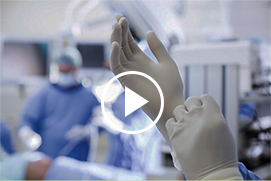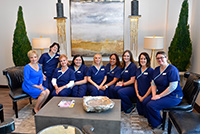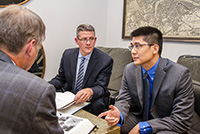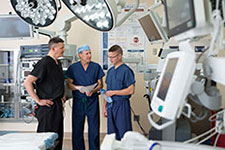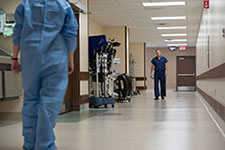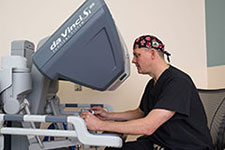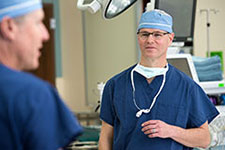What is a mastectomy?
A mastectomy is a surgical procedure in which all or a portion of a breast is removed as a part of treatment for breast cancer. In some cases, mastectomy is performed prophylactically (to prevent cancer from occurring) in women with a high risk for developing breast cancer.
Surgical treatment for breast cancer is generally divided into 2 categories: breast-conserving therapy (BCT) or mastectomy. BCT involves removing the least possible amount of breast tissue when removing breast cancer, and usually includes adjuvant (additional) therapy after surgery, most often radiation therapy.
There are several types of mastectomy procedures:
- Total (or simple) mastectomy. Removal of the entire breast, including the nipple, the areola, and most of the overlying skin.
- Modified radical mastectomy. Removal of the entire breast, including the nipple, the areola, the overlying skin, and the lining over the chest muscles. In addition, some of the lymph nodes under the arm, also called the axillary lymph nodes, may be removed. The bean-shaped lymph nodes under the arm drain the lymphatic vessels from the upper arms, the majority of the breast, the neck, and the underarm regions. Often, breast cancer spreads to these lymph nodes, thereby entering the lymphatic system and allowing the cancer to spread to other parts of the body. In some cases, part of the chest wall muscle is also removed.
- Radical mastectomy. Removal of the entire breast, including the nipple, the areola, the overlying skin, the lymph nodes under the arm, and the chest muscles. For many years, this was the standard operation. However, today a radical mastectomy is rarely performed and is generally only recommended when the breast cancer has spread to the chest muscles.
Some newer mastectomy procedures may offer additional options for surgery. However, further studies are needed to learn whether these procedures are as effective as more standard types of surgery in completely removing or preventing the return of breast cancer:
- Skin-sparing mastectomy. In this procedure the breast tissue, nipple and areola are removed, but most of the skin over the breast is saved. This type of surgery appears to be similar to modified radical mastectomy in effectiveness for many women. It is used only when breast reconstruction is performed immediately after the mastectomy and may not be suitable for tumors that are large or near the skin surface.
- Nipple-sparing mastectomy. This is similar to the skin-sparing mastectomy, and it is sometimes referred to as a "total skin-sparing mastectomy." All of the breast tissue, including the ducts going all the way up to the nipple and areola, are removed, but the skin of the nipple and areola is preserved. The tissues under and around the nipple and areola are carefully cut away and examined by a pathologist. If no breast cancer cells are found close to the nipple and areola, they can be preserved. Otherwise, nipple-sparing mastectomy is not recommended.
When all or most of the breast tissue is removed, breast reconstruction surgery may be performed to rebuild the breast. Reconstruction may be performed at the time of the mastectomy or at a later time.
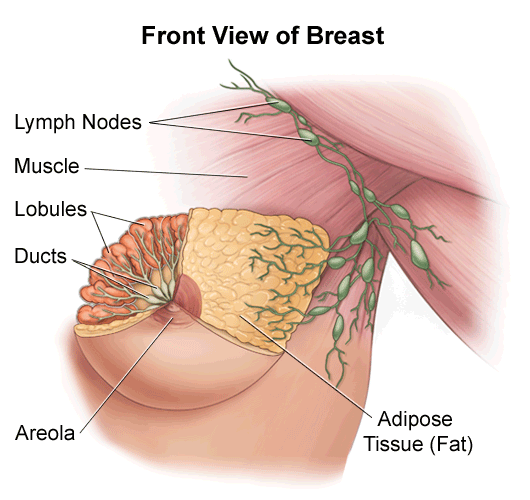
Anatomy of the breast
Each breast has 15 sections to 20 sections, called lobes, that are arranged like the petals of a daisy. Each lobe has many smaller lobules, which end in dozens of tiny bulbs that can produce milk.
The lobes, lobules, and bulbs are all linked by thin tubes called ducts. These ducts lead to the nipple in the center of a dark area of skin called the areola. Fat fills the spaces between lobules and ducts.
There are no muscles in the breast, but muscles lie under each breast and cover the ribs.
Each breast also contains blood vessels and vessels that carry lymph. The lymph vessels lead to small bean-shaped organs called lymph nodes, clusters of which are found under the arm, above the collarbone, and in the chest, as well as in many other parts of the body.
Reasons for the procedure
A mastectomy may be performed as part of treatment for breast cancer.
Women with a high risk for developing breast cancer, such as those with the BRCA1 or BRCA2 gene (tumor suppressor genes associated with breast cancer) along with other increased risks, may choose to undergo prophylactic mastectomy.
The type of surgical procedure performed for breast cancer depends on the type and extent of cancer involved. If the cancerous lump is small and localized, a lumpectomy, which is a type of BCT, may be performed, rather than a mastectomy. However, if the tumor is large with respect to the size of the breast, if it involves more than 1 area of the breast, or if there are contraindications to radiation therapy, your doctor most likely will recommend a mastectomy. The size of the breast involved may also influence the choice of procedure.
There may be other reasons for your doctor to recommend a mastectomy.
Risks of the procedure
As with any surgical procedure, complications may occur. Some possible complications of mastectomy include, but are not limited to, the following:
- Temporary swelling of the breast
- Breast tenderness
- Hardness due to scar tissue that can form at the site of the incision
- Wound infection or bleeding
- Lymphedema, or swelling, of the arm due to lymph node removal. This is preceded by early symptoms, which include a feeling of tightness in the arm, pain, redness, and decreased flexibility of the arm, hand, and wrist.
- Phantom breast pain. Symptoms include unpleasant itching, “pins and needles,” pressure, and throbbing. These sensations may be managed with medications, exercise, or massage. Phantom breast pain does not mean that cancer cells are still present in the breast or that the cancer may return.
Seroma (clear fluid trapped in a wound) is normally present after a mastectomy. Troublesome seromas can be drained in a surgeon’s office and treated with compression or an injection that helps to harden the space in the breast if necessary.
A linear scar is likely to result at the site of the mastectomy, and many patients experience a pulling sensation near or under their arm after mastectomy.
Depression and feelings of loss of sexual identity may occur after a mastectomy.
There may be other risks depending on your specific medical condition. Be sure to discuss any concerns with your doctor prior to the procedure.
Cosmetic concerns after mastectomy
Patients undergoing mastectomy may have concerns about the appearance of their breast(s) after the procedure. Fortunately, breast reconstruction is possible for the majority of patients after mastectomy. Often, patients undergoing mastectomy may undergo breast reconstruction surgery during the same procedure.
The advantages to immediate breast reconstruction include not waking up to the trauma of losing a breast and eliminating the need for additional surgery. Disadvantages include having to consider reconstruction options during an already stressful time prior to surgery for cancer. In addition, complications, though rare, may result during the healing process from reconstruction surgery that may interfere with radiation or chemotherapy treatment.
Your doctor will discuss with you your options regarding reconstructive surgery. Alternative solutions after mastectomy include the use of an external prosthesis or a special mastectomy bra.
Before the procedure
- Your doctor will explain the mastectomy procedure to you and give you a chance to ask any questions that you might have.
- You will be asked to sign a consent form that gives permission to do the procedure. Read the form carefully and ask questions if something is not clear.
- In addition to a complete medical history, your doctor may perform a complete physical examination to ensure you are in good health before undergoing the procedure. You may undergo blood tests or other diagnostic tests.
- You will be asked to fast for 8 hours before the procedure, generally after midnight.
- If you are pregnant or suspect that you may be pregnant, you should notify your health care provider.
- Notify your doctor if you are sensitive to or are allergic to any medications, iodine, latex, tape, or anesthetic agents (local and general).
- Notify your doctor of all medications (prescription and over-the-counter) and herbal supplements that you are taking.
- Notify your doctor if you have a history of bleeding disorders or if you are taking any anticoagulant (blood-thinning) medications, aspirin, or other medications that affect blood clotting. You may need to stop these medications prior to the procedure.
- You may receive a sedative prior to the procedure to help you relax.
- Based on your medical condition, your doctor may request other specific preparation.
During the procedure
A mastectomy typically requires a stay in the hospital. Procedures may vary depending on your condition and your doctor's practices.
Generally, a mastectomy follows this process:
- You will be asked to remove clothing and will be given a gown to wear.
- An intravenous (IV) line may be started in your arm or hand.
- You will be positioned on the operating table lying on your back.
- The anesthesiologist will continuously monitor your heart rate, blood pressure, breathing, and blood oxygen level during the surgery.
- The skin over the surgical site will be cleansed with an antiseptic solution.
- An incision, or cut, will be made in the breast. The type of mastectomy to be performed will determine the type of incision(s) made. (The areas removed during surgery are shaded in green in the illustrations.)
- The underlying tissue will be gently cut free and removed.
- Lymph nodes may be removed after the breast or breast tissue has been removed.
- If breast reconstruction is to be performed along with the mastectomy, a plastic surgeon will perform the procedure after the mastectomy has been completed.
- Breast tissue and any other tissues that are removed will be sent to the lab for examination.
- One or more drainage tubes may be inserted into the affected area.
- The skin will be closed with sutures or adhesive strips.
- A sterile bandage or dressing will be placed over the site.
After the procedure
In the hospital
After the procedure, you will be taken to the recovery room for observation. Your recovery process will vary depending on the type of procedure performed and the type of anesthesia that is given. Once your blood pressure, pulse, and breathing are stable and you are alert, you will be taken to your hospital room.
After a mastectomy, patients generally stay 1 day to 3 days or longer in the hospital, depending on the extent of the surgery and if breast reconstruction was also performed.
The extent of pain depends on the amount and location of tissue removed during surgery. Most soreness may last a few days, although many mastectomy patients do not experience soreness after surgery. Take a pain reliever for soreness as recommended by your doctor. Aspirin or certain other pain medications may increase the chance of bleeding. Be sure to take only recommended medications.
Radiation therapy or chemotherapy may or may not be necessary after a mastectomy. Your doctor will advise you about this depending on your particular situation.
At home
Once you are home, it is important to keep the surgical area clean and dry. Your doctor will give you specific bathing instructions. Unless instructed otherwise, the narrow strips of tape across the incision can become wet during a shower. You may be instructed to replace a wet dressing with a clean, dry one.
You will be instructed about how to take care of the drainage tube, which should be removed after about 2 weeks at the first follow-up examination.
If lymph node dissection (removal) was performed with your mastectomy, your doctor may recommend that you do exercises to help limber up the shoulder and arm area. Soreness after lymph node dissection may cause you to keep your arm and shoulder as still as possible, leading to arm and shoulder stiffness. Overdoing the exercises could result in injury so they should be started gradually and performed consistently, progressing a little each day. You may be advised to perform these exercises even if lymph node dissection was not a part of your procedure.
Normal activities can usually be resumed within a few weeks, based on a recommendation by your doctor. Meanwhile, you should avoid strenuous activities, particularly those that involve extensive use of the arm, such as cleaning windows or vacuuming for long periods. Your doctor will advise you about when you can start driving again and when you can return to work.
If you have problems dealing with your recovery, your doctor may refer you to a volunteer agency or group for support.
Notify your doctor if you have any of the following:
- Fever and/or chills
- Redness, swelling, or bleeding or other drainage from the incision site
- Increased pain around the incision site
- Swelling or numbness and/or tingling of the affected arm
Your doctor may give you additional or alternate instructions after the procedure, depending on your particular situation.
Arm care after lymph node removal
Removal of lymph nodes may affect the drainage of lymphatic fluid from the arm on the surgical side. Problems with lymphatic drainage may result in arm swelling and an increased risk for infection from trauma to the arm. In addition, there is an increased risk for blood clots in the veins of the armpit because of surgical trauma in the area.
Lifelong precautions to help prevent problems in the affected arm after lymph node dissection include, but are not limited to, the following:
- No needle sticks or IV insertions in the affected arm
- No blood pressure measurements in the affected arm
- Follow instructions regarding exercises of the arms carefully
- Avoid injuries, such as scratches or splinters, to the affected arm
- Elevate the arm, with the hand above the elbow, to assist with drainage of lymphatic fluid
- Wear gloves when gardening or performing any activity in which there is a risk for skin puncture of the fingers and/or hands, or when using strong or harsh chemicals, such as detergents or household cleaners
- Avoid sunburns
- Use an electric shaver rather than a razor with a blade to shave under the arm
- Avoid any constrictive items on the affected arm, such as elastic cuffs or tight watches or other jewelry
- Use the unaffected arm to carry heavy packages, bags, or purses
- Avoid insect bites or stings by using insect repellents and/or wearing long sleeves



